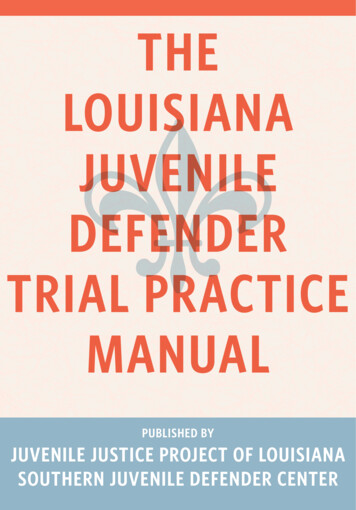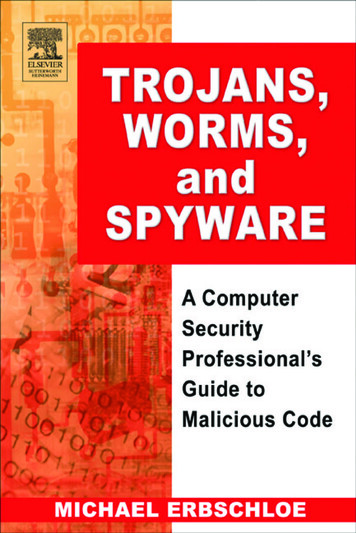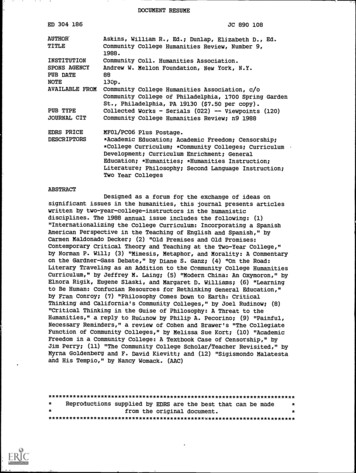
Transcription
DOCUMENT RESUMEED 304 186AUTHOR*TITLEJC 890 108Askins, William R., Ed.; Dunlap, Elizabeth D., Ed.Community College Humanities Review, Number 9,1988.INSTITUTIONSPONS AGENCYPUB DATENOTEAVAILABLE FROMPUB TYPEJOURNAL CITEDRS PRICEDESCRIPTORSCommunity Coil. Humanities Association.Andrew W. Mellon Foundation, New York, N.Y.88130p.Community College Humanities Association, c/oCommunity College of Philadelphia, 1700 Spring GardenSt., Philadelphia, PA 19130 ( 7.50 per copy).Collected Works - Serials (022) -- Viewpoints (120)Community College Humanities Review; n9 1988MF01/PC06 Plus Postage.*Academic Education; Academic Freedom; Censorship;*College Curriculum; *Community Colleges; CurriculumDevelopment; Curriculum Enrichment; GeneralEducation; *Humanities; *Humanities Instruction;Literature; Philosophy; Second Language Instruction;Two Year CollegesABSTRACTDesigned as a forum for the exchange of ideas onsignificant issues in the humanities, this journal presents articleswritten by two-year-college-instructors in the humanisticdisciplines. The 1988 annual issue includes the following: (1)"Internationalizing the College Curriculum: Incorporating a SpanishAmerican Perspective in the Teaching of English and Spanish," byCarmen Maldonado Decker; (2) "Old Premises and Old Promises:Contemporary Critical Theory and Teaching at the Two-Year College,"by Norman P. Will; (3) "Mimesis, Metaphor, and Morality: A Commentaryon the Gardner-Gass Debate," by Diane S. Ganz; (4) "On the Road:Literary Traveling as an Addition to the Community College HumanitiesCurriculum," by Jeffrey M. Laing; (5) "Modern China: An Oxymoron," byElnora Rigik, Eugene Slaski, and Margaret D. Williams; (6) "Learningto Be Human: Confucian Resources for Rethinking General Education,"by Fran Conroy; (7) "Philosophy Comes Down to Earth: CriticalThinking and California's Community Colleges," by Joel Rudinow; (8)"Critical Thinking in the Guise of Philosophy: A Threat to theHumanities," a reply to RuCiinow by Philip A. Pecorino; (9) "Painful,Necessary Reminders," a review of Cohen and Brawer's "The CollegiateFunction of Community Colleges," by Melissa Sue Kort; (10) "AcademicFreedom in a Community College: A Textbook Case of Censorship," byJim Perry; (11) "The Community College Scholar/Teacher Revisited," byMyrna Goldenberg and F. David Kievitt; and (12) "Sigismondo Malatestaand His Tempio," by Nancy Womack. **************************Reproductions supplied by EDRS are the best that can be madefrom the original ****w*************************
COMMUNITY COLLEGEHUMANITIES REVIEW"PERMISSION TO REPRODUCE THISMATERIAL HAS BEEN GRANTED BYU.S. DEPARTMENT OF EDUCATIONOffce of Educational Research and ImprovementEDUCATIONAL RESOURCES INFORMATIONCENTER (ERIC)D. Schmeltekopf)(Tnis document has been reproduced asreceived from tne person Or organizationoriginating it.C Minor changes have been made to nnpfovereproduction QualityTO THE EDUCATIONAL RESOURCESINFORMATION CENTER (ERIC)."Pants of view or opinions stated in trsdocu-ment do not necessarily represent official0E111 posthon or policy19884.0COrINumber 9ESSAYS, ARTICLES, AND REVIEWS BY:O) Carmen Maldonado DeckerCypress Collegeri1Norman P. WillUnion CollegeL.LJDiane S. GanzMontgomery CollegeJeffrey M. LaingSanta Fe Community CollegeElnora RigikBrandywine CollegeEugene SlaskiAllentown Campus, Penn StateMargaret D. WilliamsGenesee Community CollegeFran ConroyBurlington County CollegeJoel RudinowSanta Rosa Junior CollegePhilip A. PecorinoQueensborough Community CollegeMelissa Sue KortC)00O( 0Santa Rosa Junior CollegeJim PerryHillsborough Community CollegeMyrna GoldenbergMontgomery CollegeF. David KievittBergen Community CollegeNancy H. WomackIsothermal Community College2BEST COPY AVAILABLE
Community CollegeHUMANITIES REVIEW(ISSN 0748-0741)Published annually by the Community College Humanities Association. Singlecopies are available at 7.50 per copy. Please address all correspondence to:Community College Humanities ReviewCommunity College Humanities Associationc/o Community College of Philadelphia1700 Spring Garden StreetPhiladelphia, PA 19130Telephone: (215) 751-8860Copyright @1988 by the Community College Humanities Association. Allrights reserved.The Commun' y College Humanities Association is a nonprofit organizationdevoted to promoting the teaching and learning of the humanities in community and twoyear colleges.The Association's purposes are:To advance the cause of the humanities in community colleges throughits own activities and in cooperation with other institutions and groupsinvolved in higher education;To provide a regular forum for the exchange of ideas on significant issuesin the humanities in higher education;To encourage and support the professional work of teachers in the humanities;To sponsor conferences and institutes to provide opportunities for facultydevelopment;To promote the discussion of issues of concern to humanists and to disseminate information about the Association's activities through its publications.The Association's publications include:The Community College Humanities Review, a journal for the discussion of substantive issues in me humanistic disciplines and in the humanitiesin higher education;The Community College Humanist, a triannual newsletter;Proceedings of the Community College Humanities Association;Studies and reports devoted to practical concerns of the teaching profession.(.3
COMMUNITY COLLEGEHUMANITIES REVIEWEditorManaging EditorWilliam R. AskinsElizabeth D. DunlapPublications CommitteeRichard KalfusSt. LouisCommunity CollegeMichael McCarthyCommunity Collegeof DenverRobert LawrenceJeffersonCommunity CollegeLamar York, ChairDe KalbCommunity CollegeInformation for AuthorsThe editors invite the submission of articles bearing upon issues in the humanities. Manuscripts and footnotes should be doublespaced throughoutand submitted in triplicate, and should follow the guidelines published in theChicago Manual of Style. Preference will be given to submisions postmarked before May 15 and demonstrating familiarity with current ideas andthe scholarly literature on a given subject. Procedures for reviewing manuscripts provide for the anonymity of the author and the confidentiality ofeditors' and readers' reports. Editorial policy does not provide for informingauthors of evaluations or suggestions for improving rejected manuscripts.Authors should include a selfaddressed, stamped envelope if return of themanuscript is desired and should provide a fiftyword biographical statementindicating positions held and publications. Statements of fact and opinionappearing in the Review are made on the responsibility of the authors aloneand do not imply endorsement by the Community College Humanities Association or the editors.CCHA wishes to acknowledge the generous support ofthe Mellon Foundation.4
Remarks from the EditorLongtime readers of the Review will notice that this issue represents aconsiderable and perhaps significant departure from previous editorialpractice. Though the articles in previous issues were of course relevant tothe community college scene, few of them were in fact written by community college humanists. The editor and some members of the CCHAhave felt the need to change this, and so for this issue all contributionshave been selected from manuscripts submitted by persons who teach attwo-year colleges. To the extent that this proves agreeable to members ofthe CCHA, this practice will continue in the future.The collection of articles which has been the result of this editorial initia-tive might be open to several criticisms. For one thing, this issue hasconsiderably less focus than previous numbers and is less heavily slantedtowards articles that deal exclusively with pedagogical concerns. Aseclectic as the contents may be, it nonetheless seems to me that thiscollection of material accurately reflects the diversity of interests characteristic of community and junior college faculty. The contributors havedealt with political issues that bear upon the work of community collegefaculty, with the theoretical underpinnings of classroom practice, witheducational travel, and with critical issues discussed without any reference to the classroom whatsoever. This issue also contains the first specimen of scholarship from a community college teacher that has appearedin the journal's ten-year history.A second objection to the journal as it stands might be that most of thearticles come from within the disciplines of English and Philosophy. Iwish that were not the case, and I would urge, if not beg, historians,teachers of art and music, and teachers of breign languages and literatures, religion, and interdisciplinary humanities courses to send theirwork to the Review.I would also ask readers who have second thoughts about these mattersand any other issues raised by this edition of the journal to send them tothe editor. All letters will be answered promptly and printed in the Humanist if appropriate. All new submissions will be read immediately uponreceipt, and authors will be quickly informed of the disposition of theirwork.W.R.A.U
atCOMMUNITY COLLEGE HUMANITIES REVIEW1988ContentsNumber 9Internationalizing the College Curriculum: Incorporatinga Spanish American Perspective in the Teaching of English and Spanish3Carmen Maldonado DeckerOld-Premises and Old Promises: Contemporary Critical Theoryand Teaching at the TwoYear College9Norman P. WillMimesis, Metaphor, and Morality:A Commentary on the GardnerGass Debate19Diane S. GanzOn the Road: Literary Traveling as an Addition to theCommunity CollegeHumarnties Curriculum45Jeffrey M. LaingModern China: An Oxymoron50Elnora Rigik, Eugene Slaski, and Margaret D. WilliamsLearning To Be Human: Confucian Resourcesfor Rethinking General Education59Fran ConroyPhilosophy Comes Down to Earth: Critical Thinkingand California's Community CollegesJoel RudinowCritical Thinking in the Guise of Philosophy: A Threat tothe Humanities8088Philip A. PecorinoPainful, Necessary Reminders97Melissa Sue KortAcademic Freedom in a Community College:A Textbook Case of Censorship100Jim PerryThe Community College Scholar/Teacher Revisited108Myrna Goldenberg and F. David KievittSigismondo Malatesta and His TempioNancy Womack116
3Internationalizing the College Curriculum:Incorporating a Spanish American Perspective inthe Teaching of English and SpanishCarmen Maldonado DeckerFor the last few months, Stanford University faculty have been debating aproposal to make their freshman Western culture program better reflect theachievements of women, minorities, and Third World cultures. A task forcewas appointed to consider the possibility of changing the title of the threeterm requirement in Western culture to "Culture, Ideas, and Values." Therevised program would include the study of at least one nonEuropean culturn and, as supporters of the proposal contend, would redefine the meaningof the term Western civilization. Joe Platt, professor of history at CaliforniaState University, Fullerton, strongly supports the proposed change at Stanford. In a recent interview for the Orange County Register, he indicated that"the term Western civilization sounds too ethnocentric, because when peopletalk about it, they don't mean the Incas or Mayas, who are the original creators in this hemisphere." He agrees with other educators that "America isbecoming more Third World and we should broaden our curriculum to include this pluralism."1The controversy over the internationalization of the humanities curriculum atStanford has attracted national attention. Many regard the proposed changeas a direct contradiction to the recommendations made by William Bennett?In "To Reclaim a Legacy," Bennett indicated that "the core of the Americancollege curriculum, its heart and soul, should be the civilization of the West."He added that "it is simply not possible for students to understand their society without studying its intellectual legacy. If the past is hidden from them,they will become aliens in their own culture, strangers in their own land."Carmen Maldonado Decker received her Ph.D. in comparative literaturefrot2 the University of California. She teaches English and Spanish at Cypress College and served as one of the codirectors, along with Julio Ortega,of the 1987 NEHfunded summer institute on Contemporary Spanish American Literature sponsored by CCHA.
4DeckerEducators today do not question this basic assumption; however, they doquestion the narrow interpretation of the term "civilization of the West" andare attempting to redefine it in order to beater reflect the overall culturalheritage of the Western Hemisphere.The debate over the internationalization of the college curriculum has beenparticularly heated in academic circles 'n CalifornL because the state hasbeen the major gateway for Asian and Latin American immigration in thesecond half of this century. In a recent interview published in The New Perspectives Quarterly, California Assembly member Toni Hayden remarkedthat some agreement should be reached regarding the content of a core curriculum, but he also indicated that "there are numerous legkimate issuesaround the boundaries of a curriculum." He explained that, "for example, inCalifornia, the cultures of Mexico an:. the Pacific are very important. Toleave out Carlos Fuentes or Gabriel Garcia Marquez would be a tragedy."3Educators and legislators throughout the nation have attempted to respond tovarious calls for reform in the undergraduate curriculum through the proposed development of a general education core curriculuni and through appeals to colleagues to consider the social, economic, and educational necessity for the internationalization of the curriculum. In 1985, the Association ofAmerican Colleges issued a report entitled "Integrity in the College Curriculum," which included the following recommendation:How should a college go about opening the eyes and minds of its students tothe shrinking world in which they live and to the aspirations of women and ofthe ethnic minorities who are redefining American social and political reality? There are opportunities in many solidly entrenched disciplines of thecurriculum to widen access to the diversity of American and world cultures.The study of foreign language and literature can be enriched by exploring theculture of which it is an artifact.'Because California has been oriented historically, geographically, economically, and culturally to Asia and Latin America, there is a presAng need tomodify the assumption among politicians, academicians, and stu lents thatthe basic unit of social life is the e:screte nation, society, or culture. It isbecoming increasingly evident that the curriculum in our colleges and universides should be revised to incorporate a broader perspective on the pluralismof today's society. Neil Smelser, professor of sociology at Berkeley, believesthat "the twin phenomena of internationalizaticn and interdependency arerendering this fundamental premise questionable and demand novel ways ofthinking, analyzing, and understanding." In California, in particular, a combination of migration and differential birth rates among ethnic groups hasresulted in trends that have made California truly multicultural and multilin-
Internationalizing the College Curriculumgual. These trends are expected to accelerate during the coming decades tothe point that those now designated as minorities will will constitute a majorityat the turn of the century. It is thus more than time that our curriculumreflect and explain the nation's cultural heterogeneity through a comparative,multicultural, or global approach.The initiative for promoting the internationalization of the curriculum rightlybelongs to the faculty of the community colleges. A 1985 survey conductedby the American Council on Education revealed that most humanities courses(87 percent) are taken by students during the first two years of their collegeeducation, placing a particular responsibility on the community colleges tostrengthen and examine the content of their general education curriculum. Itis disconcerting to discover that only 47 percent of Anierican colleges anduniversities require a foreign language for graduation, as compared with 89percent in 1966. This trend is particularly alarming because one of the inherent values in the study of a foreign language is that students learn to understand and respect cultu traditions and values other than their own.In 1987, the UCLA student body association published a report entitled ANeed for Reform: A Student Perspective on UCLA Undergraduate E !ucation,which outlined several areas where the students felt that their undergraduateeducation had been neglected and made specific recommendations for improvement. In the area of foreign languages they stated:students should know how to write, read, and converse in at least one language other than English before leaving the university. It is a tragedy thatwhile America is a leader in so many areas, we are perhaps one of the mostbackward countries with respect to educating ourselves about the world beyond the United States of America. Our state is rapidly changing and diversifying in ethnicity, culture, and language. It is time to stop neglecting thesechanges.eWith this need for cultural reform in raind, and with languages and literatureas the logical fields for internationalizing the college curriculum, the Community College Humanities Association sponsored a four-week summer instituteon contemporary Spanish American lite.- time at Columbia University in NewYork in 1987. The institute, funded by a grant from the National Endowmentfor the Humanities, involved forty faculty participants representing variousdisciplines from two-year and four-year colleges and universities from allover the nation. The institute was designed to provide an intellectual environment that would expose faculty to the most recent developments in SpanishAmerican literature. It was promoted in order to attract faculty trained inAmerican or European literature to consider broadening their curriculum byincorporating a component of Spanish American literature into their courses.9
Decker6It was also intended to appeal to faculty teaching in Spanish departments whohas been trained in Spanish Peninsular or Golden Age literature and whowanted an opportunity to update their knowledge of more recent literaryworks by contemporary Spanish American writers. The institute was alsoplanned to encourage the development of innovative pedagogical applicationsto the teaching of contemporary Spanish American literature in various disciplines.While the institute focused primarily on major works of fiction by GabrielGarcia Marquez, Carlos Fuentes, Alejo Carpentier, and Jose Maria Arguedas, much time was also devoted to discussing the recent fiction of Spanish American women writers as well as Puerto Rican and Chicano authors.The specific works chosen to study, One Hundred Years of solitude, Th Death of Artemio Cruz, Deep Rivers, and War of Time, were selected notonly for their literary merit but also because they reflect issues in SpanishAmerican history, culture, politics, and ethnological self-definition that areso important to an adequate understanding of Latin America. Institute lecturers provided not only a literary approach to these works, they also offered ahistorical and socio-cultural analysis of the environment within which eachauthor developed his or her own view of reality. This approach was importantbecause college faculty interested in internationalizing the curriculum will beable to use a component of Spanish American literature in their courses as avalid vehicle for exploring the cultural ideas and historical epochs that haveinfluenced the formation of Latin American society, both within and beyondthe political boundaries of the United States. Because Spanish American culture is so much a product of the synthesizing and blending of Spanish, Indian, and African cultures, writers from these varied ethnic backgrounds canoffer students a better understanding of the contributions that each culturalgroup has made to the social and historical development of Latin America,which, in turn, helps students realize how their view of reality has beenshaped and molded by the cultural norms of their own society.Deep Rivers, by Peruvian author Jose Maria Arguedas, was the first majorwork studied during our summer program. Professor Jose Maria Rabasa ofthe University of Texas (Austin) led the discussion of this lyrical novel. DeepRivers is a powerful study of the problems of ethnicity, socia:ization, andcommunication in the pluralistic culture of Peru. Discussion of this novelnoted the clash of the Indian and mestizo societies of Peru and lent itself to acritical approach that made use of the interaction between literature and anthropology. The musical and poetic Indian world of the Quechua Indian, asdepicted by Arguedas, is still permeated by a magical and pagan view of reality. This pristine view is contrasted with the conflicting world .f the Peruvian-10,
Internationalizing the College Curriculum7mestizo, whose values and religion have been greatly influenced by Europeanculture. The presence of these two perspectives in the novel highlights one ofthe recurring themes in Spanish American literature: the cultural syncretismthat has occurred in Latin America through the historical resistance of aboriginal America to the strong forces of colonization by the European,;.Professor Ricardo Gutierrez-Mouat of Emory University lectured on the formal and cultural aspects of One Hundred Years of Solitude, by Colombiannovelist Gabriel Garcia Marquez. The extensive critical bibliography on theNobel laureate made it possible to present a variety of formal approaches tothe novel's multiple narrative techniques, manipulation of time, and use ofmagic realism. Discussion focused on the novel's peculiar system of interchange, on one level as cultural discourse and on the other as the product oforal traditions. The prevalent use of various levels of myth in this novel permitted demonstrations of the use of new critical tools such as semiology, textual decodification, and systems of sign correlations.Professor Roberto Gonzalez-Echevarria of Yale University sha.ed with participants his wealth of knowledge regarding both the historical and culturalapproaches to War of Time, by Cuban writer Alejo Carpentier. This dualapproach facilitated the demonstration of another area of critical interaction:the literary text and the use of Spanish American history. It was possible torelate Alejo Carpentier's elaboration of a baroque literature to that of LatinAmerican history in search of its identity through a series of European influences. Participants had an opportunity to examine the impact of the FrenchRevolution on the history of the Caribbean and the influence of French philosophy in Carpentier's depiction of time.Carlos Fuentes' The Death of At temio Cruz was the focus of the final week ofstudy. Professor Saul Sosnowski of the University of Maryland lectured onFuentes' complex exploration of modern Mexican history and politics. Thisseminal work is seen as marking the end of the historical narrative on theMexican revolution and beginning a new era of political revision. In thisnovel, Fuentes uses a complex interweaving of modernist narrative techniques to convey the fractured reality of a failed revolution. The central char-acter in the novel represents the failed idea of an ideological revolutionstopped short by the socio-economic realities of individual and collective cor-ruption. Through the main character, Fuentes traces the development ofmodern Mexican history and analyzes the political realities of greed, violence, and corruption present in today's Latin America.The summer institute gave the participants an opportunity to meet other specialists in the field and to share teaching methodologies and discuss commonJ, .2.
Decker8educational concerns with other colleagues. Many of them have indicatedthat the opportunity for dialogue with fellow participants and the lecturers wasone of the most valuable aspects of the institute. Foi many, the research andlibrary facilities at Columbia University and the intellectual and cultural envi-ronment of New York City offered a muchneeded opportunity for professional development and renewal. However, the single most important resultof the institute has been the revision of the participants' college curricula.Judging from the reports submitted last fall and early this spring, most institute participants have been successful in revising their curricula to include aninternational perspective. Many have developed their own courses, such ascomparative courses on Canadian, American, and Latin American Indianmythology (Portland Community College), interdisciplinary courses on Mexi-can literature and Mexican murals (St. Joseph's College in California), theinternationalization of drama courses (University of South Carolina), andeven the internationalization of English composition (Santa Barbara City College). Professor Hilbrink's syllabus for an English composition course includes readings from Garcia Marquez, Jorge Luis Borges, Gabriela Mistral,and Manuel Puig.Because the population of the United States is being composed in everincreasing numbers of people whose first language is Spanish, and since morecountries today speak Spanish than ever in history spoke one language, theincorporation of a component of Spanish American literature and culture incollege courses would appear to be a valid approach to internationalizing thecurriculum and exposing stu:ents to the ideas and values of an increasinglyimportant region in our world.NotesJoe Platt, "Curriculum Changes Considered", Orange County Register, April 7, 1988.1 William J. Bennett, "To Reclaim a Legacy," Chronicle of Higher Education, November28, 1984, pp. 16-21.a Tom Hayden, "Our Finest Moment," New Persiectives Quanerly, Winter 1983.Association of American Colleges, "Integrity in the College Curriculum" (1985, reprintedfrom the Chronicle of Higher Education).5 Neil J. Smelser, Lower Division Education in the University of California (Berkeley.University of California, 1986), p. 30.UCLA Student Body, A Need for Reform. A Student Per-pective on UCLA UndergraduateEducation (Los Angeles, May 1985), p. 9.12
9Old Premises and Old Promises:Contemporary Critical Theory and Teaching atthe Two-Year CollegeNorman P. WillThe president of my colleg., Union County College in New Jersey, has recently found it useful to describe my background to various audiences insideand outside the college. As he often explains, I hold a Ph.D. in literaturefrom Rutgers University. I was for four years chairman of the largest department at the college, the English/Fine Arts/Modern Languages Department. Ihave done postdoctoral study at Princeton University and at the School ofCriticism and Theory at Dartmouth. I am one of the designers and foundingfaculty members of Gur honors program. The president points all this out as acontrast to what I am now doing for a living, implementing a grant that has,among other things, created a high school for minority students on our maincampus. His implication is that if I have been willing to almost completelyabandon the profession I have been trained for, this controversial grant project must be crucially important, despite the criticism and even incredulity itoften generates among college and community constituencies.What strikes me most about the president's use of me as a public relationspoint is his assumption, never questioned by any audience I have heard himaddress, that my involvement with secondary education and with minorityissues in education is somehow at variance with my training. At first glance, Isuppose he appears right, though some elements of that training were apparently subversive enough not only to allow me to experience a continuity in mycareer, but even to see my current work as an enactment of much of thesocalled literary theory that I have studied in recent years, theory oftendeemed irrelevant to teaching and working at a twoyear college. But myexperience and my training lead me to view the twoyear college as a uniqueopportunity to combine theory and practice, as a place where theory andpractice can interpenetrate and become mutually validating.Norman P. Will is Senior Professor of English at Union County College inCranford, New Jersey.3
10WillWhat other institution in American education would pay me to spend a summer studying with J. Hillis Miller, Geoffrey Hartman, and Elaine Showalter,knowing that I would soon be struggling with such practical concerns asschool buses and physical education classes for fifteenyearold potentialdropouts?I recall that when I arrived in 1977 at what was then a private twoyearschool called Union College, with my doctorate in hand and with eight yearsof experience teaching at a high school and at fouryear colleges and universities, I was shocked by the students in my classrooms. Some were older thanI was. Many seemed emotionally fragile, some clearly disturbed. Some wereworking fulltime while trying to squeeze in as many as fifteen credits persemester. Even the supposedly "traditional" students, the eighteen andnineteenyearolds, did not match my expectations. Some were at schoolonly to placate their parents. Many had weaker skills than I had encounteredin my high school teaching experience. Yet there we all were, together in oneroom, working through th same syllabus I had used most recently as a teaching assistant at Rutgers L niversity, reading selections from the same canonized anthologies. Yet the only similarity between the classes at Rutgers and atUnion was racial: almost all students in my classes were white.Wh
Community College Humanities Review, Number 9, 1988. Community Coil. Humanities Association. Andrew W. Mellon Foundation, New York, N.Y. 88 130p. Community College Humanities Association, c/o Community College of Philadelphia, 1700 Spring Garden St., Philadelphia, PA 19130 ( 7.50 per copy). Collected Works - Serials (022) -- Viewpoints (120)

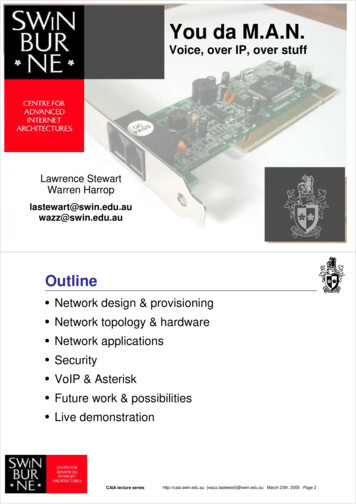
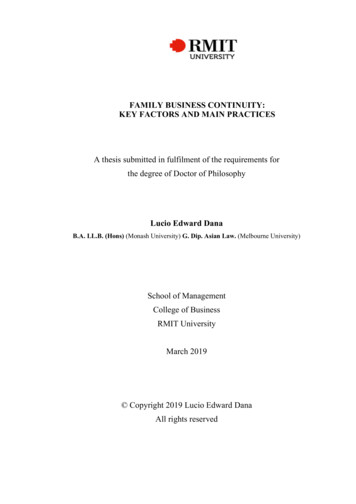



![Index [ astm ]](/img/5/stp37775s-index.jpg)

